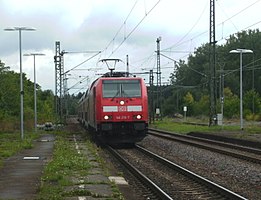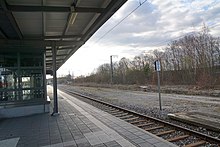Eutingen im Gäu train station
| Eutingen in the Gäu | |
|---|---|
| Data | |
| Location in the network | Separation station |
| Design | Through station |
| Platform tracks | 3 |
| abbreviation | TET |
| IBNR | 8000101 |
| Price range | 4th |
| opening | June 1, 1874 (old train station) October 8, 1933 (current station) |
| Profile on Bahnhof.de | Eutingen_im_Gaeu |
| location | |
| City / municipality | Eutingen in the Gäu |
| country | Baden-Württemberg |
| Country | Germany |
| Coordinates | 48 ° 28 '47 " N , 8 ° 46' 58" E |
| Railway lines | |
|
|
| Railway stations in Baden-Württemberg | |
At the Eutingen im Gäu train station , the Gäubahn Stuttgart - Singen and the Gäubahn Stuttgart - Eutingen - Freudenstadt separate .
location
The Eutingen im Gäu train station is located on the plateau approx. 3 km east of the core town of Eutingen in the Rohrdorf district of the Gäubahn Stuttgart – Singen and is the starting point of today's Gäubahn branch line, which was historically built as the Gäubahn Eutingen – Freudenstadt , as well as the location of a substation .
history
First train station (1874–1933)
The first station in Eutingen was opened on June 1, 1874 when the Nagold Valley Railway went into operation . It was in the southeast of the town. It was expanded in 1879 with the construction of the Gäu Railway from Stuttgart , which was introduced into the station at the northern end. At that time the station had a provisional administration building , a goods shed , a locomotive depot and an office building .
The station was in operation until 1933 and until the end had a house platform , three central platforms , a turntable , a three-tier locomotive shed and extensive facilities for freight traffic .
Second train station from 1933
In February 1927, a state treaty was signed between the state of Württemberg and the Deutsche Reichsbahn-Gesellschaft to improve the rail link from Stuttgart via Horb and Tuttlingen to Singen. The subject was also the double-track expansion of the connection as well as a complete new planning for the Eutingen station.
The entire station was rebuilt east of the previous site in the direction of Ergenzingen . The tracks were designed in such a way that trains from Stuttgart to Freudenstadt could also run without changing direction . The local goods facility remained at the old location. A connecting curve was built for the trains of the Nagold Valley Railway, which was put into operation together with the new station on October 8, 1933. Since then the Nagoldtalbahn trains no longer run to Eutingen, but only to Horb / Tübingen .
On September 29, 1974, in the course of the electrification of the section from Böblingen to Horb, electrical operations began at Eutingen station and the station was thus partially integrated into the electrical Stuttgart suburban traffic .
In 1974 steam operation also ended here ; the turntable and the engine shed were demolished in 1975. The local goods facility was also abandoned.
In 1983 the second track in the direction of Hochdorf was shut down and later also dismantled.
On May 29, 1988 the station was given a new name: Eutingen (Württ) became Eutingen im Gäu .
On April 18, 1989, a new relay interlocking (type MC L84 ) was put into operation. It replaced three mechanical signal boxes from 1912.
In 2006 the line to Freudenstadt was finally electrified .
The main building has been renovated since January 2015, and the new private owner attaches great importance to originality. The wooden shingle facade was restored and painted in the original color.
Structural systems
While the station had eight tracks in 1933, there are just three platform tracks left today. The station building from 1933 is still standing, but it looks oversized with a length of 40 meters, a width of 12.6 meters and a height of 16 meters. Due to numerous dismantling measures, the station has large fallow areas .
Rail operations
Passenger trains mainly use platform track 3, the other two tracks are mainly used during rush hour.
Long-distance transport
| route | Clock frequency | vehicles | |
|---|---|---|---|
| IC 87 | Stuttgart - Böblingen - Eutingen im Gäu - Horb - Rottweil - Tuttlingen - Singen - Schaffhausen - Zurich | individual trains in the morning | ÖBB 1016/1116 & SBB Eurocity coaches |
Regional traffic
| route | Clock frequency | vehicles | |
|---|---|---|---|
| RE 14A | Stuttgart - Boeblingen - Herrenberg - Eutingen im Gäu - Horb - Rottweil | Every two hours (runs between Stuttgart and Eutingen with the RE line Stuttgart-Freudenstadt as a common train) | BR 442 |
| RE 14B | Stuttgart - Boeblingen - Herrenberg - Eutingen im Gäu - Freudenstadt | Every two hours (runs between Stuttgart and Eutingen with the RE line Stuttgart-Rottweil as a common train) | BR 442 |
| RB 14A | Stuttgart - Boeblingen - Herrenberg - Eutingen im Gäu - Horb | individual pairs of trains in the evening Monday to Friday | BR 442 |
| RB 14A | (Villingen (black.)) - Horb - Eutingen im Gäu - Bondorf (b Herrenberg) - Herrenberg | individual pairs of trains in the morning, at noon and in the evening Monday to Friday | BR 442 , BR 612 |
Light rail
| route | Clock frequency | |
|---|---|---|
| S 8 | Karlsruhe Tullastraße / Verkehrsbetriebe - Karlsruhe market square - Karlsruhe station forecourt - Rastatt - Forbach (Schwarzw) - Freudenstadt - Eutingen im Gäu - Bondorf (b Herrenberg) (- Herrenberg ) | at least every two hours |
| P 81 | Eutingen im Gäu - Hochdorf (b Horb) - Schopfloch (b Freudenstadt) - Freudenstadt city - Baiersbronn station - Weisenbach - Menzingen (Baden) | a pair of trains in the mornings Monday to Friday |
See also
- History of the railway in Württemberg with maps for the completion of the Gäubahn compared to the growth of the entire Württemberg rail network
literature
- Jürgen Gaßebner, Claus-Jürgen Jacobson: Railway systems from the air . Transpress-Verlag, ISBN 3-613-71098-6 .
Web links
- Location, track systems and some signals and permitted speeds of the station on the OpenRailwayMap
- Query the course book route 740 at Deutsche Bahn
- Query of course book route 741 at Deutsche Bahn
Individual evidence
- ↑ List of German signal boxes. Entries E. In: stellwerke.de. March 21, 2020, accessed April 5, 2020 .



